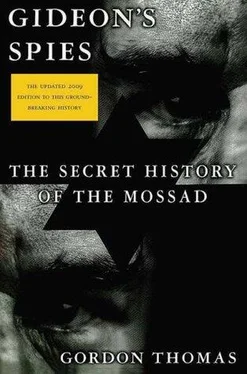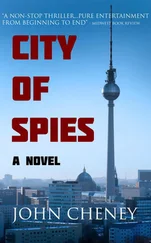Gordon Thomas - Gideon's Spies
Здесь есть возможность читать онлайн «Gordon Thomas - Gideon's Spies» весь текст электронной книги совершенно бесплатно (целиком полную версию без сокращений). В некоторых случаях можно слушать аудио, скачать через торрент в формате fb2 и присутствует краткое содержание. Город: New York, Год выпуска: 2009, ISBN: 2009, Издательство: Thomas Dunne Books, Жанр: История, на английском языке. Описание произведения, (предисловие) а так же отзывы посетителей доступны на портале библиотеки ЛибКат.
- Название:Gideon's Spies
- Автор:
- Издательство:Thomas Dunne Books
- Жанр:
- Год:2009
- Город:New York
- ISBN:978-0-312-53901-6
- Рейтинг книги:4 / 5. Голосов: 1
-
Избранное:Добавить в избранное
- Отзывы:
-
Ваша оценка:
- 80
- 1
- 2
- 3
- 4
- 5
Gideon's Spies: краткое содержание, описание и аннотация
Предлагаем к чтению аннотацию, описание, краткое содержание или предисловие (зависит от того, что написал сам автор книги «Gideon's Spies»). Если вы не нашли необходимую информацию о книге — напишите в комментариях, мы постараемся отыскать её.
Gideon’s Spies
Gideon's Spies — читать онлайн бесплатно полную книгу (весь текст) целиком
Ниже представлен текст книги, разбитый по страницам. Система сохранения места последней прочитанной страницы, позволяет с удобством читать онлайн бесплатно книгу «Gideon's Spies», без необходимости каждый раз заново искать на чём Вы остановились. Поставьте закладку, и сможете в любой момент перейти на страницу, на которой закончили чтение.
Интервал:
Закладка:
Standing before a plasma screen, he used a remote control to illuminate it. For the first time the pilots saw the target; a complex deep inside Syria almost one hundred miles northeast of Damascus. He explained there was “good and sufficient intelligence” to destroy the complex, which the Syrians were using to build nuclear bombs. He waited for the flicker of response then continued. Under the cover of being an agricultural research center, the complex was already engaged in extracting uranium from phosphates. Soon it would have weapons-enriched plutonium coming from North Korea. He told them the Israeli satellite Ofek-7, which had been launched only two months before, had been geo-positioned to watch the activities at the complex near the small Syrian city of Dayr az-Zawr. He indicated its position on the screen. No bombs must fall on civilians.
Shkedy then turned to the route in and out of the target area. The aircraft would fly up along the Syrian coast and enter its airspace at the last moment north at the port town of Samadogi and then follow the border with Turkey. At the point where the River Euphrates began its long journey south into Iraq, the attack force would swing south to the Syrian desert town of ar-Raqqah beyond which they would begin the bombing run. The way out would be a high-altitude straight run between the Syrian towns of Hims and Hamah to the Mediterranean. Over the coast of Lebanon they would turn south and return to base. The total mission time would be eighty minutes. In the event of an emergency, navy rescue launches would be positioned off the Syrian coast.
He ended the briefing by saying the attack would be in the early hours of the morning and would take place “soon.” For a moment longer the air force commander looked at the small group of pilots. Perhaps sensing their one concern, he added that every step would be taken to ensure Syria’s vaunted air defenses would be jammed. He did not say how and no one asked. It was a mark of the trust and respect they had for General Eliezer Shkedy.
The genesis for the operation ensued three years prior when a massive explosion on a North Korean freight train heading for the port of Namp’o occurred on April 22, 2004. Mossad agents had learned that in a compartment adjoining a sealed wagon were a dozen Syrian nuclear technicians who had worked in the Iranian nuclear program at Natanz, near Tehran, and had arrived in North Korea to collect the fissionable material stored in the wagon. The technicians died in the train explosion, and their bodies were flown home in lead-encased coffins aboard a Syrian military plane. By then a wide area around the explosion site had been cordoned off and scores of North Korean soldiers in anti-contamination suits had spent days recovering wreckage and spraying the entire area. Mossad analysts suspected they were recovering some of the estimated fifty-five kilos of weapons-grade plutonium North Korea possessed. Since the explosion—its cause never established—the intelligence service had tracked Syrian military officers and scientists on a dozen trips to Pyongyang where they met with high-ranking officials in the regime. The most recent meeting was shortly before the al-Hamed had left Namp’o.
It was Kamal’s report and photographic evidence of the arrival and unloading of the ship that was the focus of the meeting in General Shkedy’s headquarters on September 4, 2007. The air force commander’s briefing room was dominated by large plasma screens on two walls. One contained a blow-up of the ship and the covered crates being off-loaded and driven away. A second screen showed the town of Dayr az-Zawr. A third screen displayed a satellite image of a large square building surrounded by several smaller ones and a security fence. The area was identified by the word: “Target.”
Seated around the conference table with Prime Minister Ehud Olmert were the other key players in the operation, codenamed “Sunburst.” For Olmert, it was further proof of his powers of survival. A year ago he had been close to being driven out of office after the debacle of the war in Lebanon when he was vilified as the most incompetent leader Israel had ever had. He had fought back, appointing Ehud Barak as his new defense minister and Tzipi Livni as foreign minister. Both now flanked him at the table giving Olmert the political support he needed for “Sunburst.” Beside them sat Benjamin Netanyahu, a former prime minister and now leader of the Likud Party. Like Barak, Netanyahu was experienced in the complexities of “black” operations. Barak had been a leader in Sayeret Matkal, Israel’s elite commando force who bore the same motto as Britain’s SAS: “Who Dares Wins.” Netanyahu had approved several Mossad missions while in office.
The lynchpin of “Sunburst” was Meir Dagan. Early in the summer, he had presented Olmert with evidence of what he called “the nuclear connection” between Syria and North Korea that had reached a dangerous level. Syria already possessed sixty Scud-C missiles, which it had bought from North Korea, and on August 14, when the freighter al-Hamed was already bound for Syria, North Korea’s foreign trade minister, Rim Kyung Man, was in Damascus to sign a protocol on “cooperation and trade in science and technology.” Afterward the minister had flown to Tehran, furthering the triangular relationship between North Korea, Syria, and Iran.
Mossad’s analysts had concluded that Syria was not only a conduit for the transport to Iran of an estimated £50 million of missiles, but also could serve as “a hideout” for North Korea’s own nuclear weapons, particularly its plutonium, while the regime continued to promise it would give up its nuclear program in exchange for the massive security guarantees and financial aid the West had promised.
Until recently, Meir Dagan had remained uncertain whether this was the case. Now, the latest intelligence from his agents in the country showed that Syria was determined to create its own nuclear weapons.
The meeting had been called to discuss the matter. Dagan began by saying the crates unloaded from the al-Hamed had been tracked by Israel’s satellite to the complex. Dagan continued the meeting with his usual succinct analysis. The building was now almost certainly to be where the crates had been delivered. Inside its main structure was the machinery to cast the warheads for housing the weaponized plutonium. Scientists at Dimona had concluded that a small quantity of polonium and beryllium would be used to create the chain reaction for the plutonium, after the pellets were machined in “glove boxes,” sealed containers accessed only by special laboratory gloves to protect the technicians at the site. Dagan had concluded with a final warning: the longer Israel waited to destroy the site, the closer the technicians in the building would come to creating their weapons.
Within minutes the decision was taken to eliminate the complex.
In the late evening of September 5, 2007, Israeli commandos from the Sayeret Matkal dressed in Syrian army uniform crossed into Syria over its northern border with Iraq. They were equipped with a laser guidance system designed to guide aircraft to the target. With them were specialists from the Israeli Defense Forces. In their backpacks was equipment linked to IDF electronic counter-measure jamming technology designed to disrupt Syria’s formidable air defenses. When they were forty miles from the target the men hid and waited.
At their airfield in the Negev, the five mission pilots sat down to a large dinner. Even though they were not hungry, they knew they would need all the nutrients for the sheer physical energy and mental skills they would expend in the coming hours. Afterward they went to the briefing room where Shkedy was waiting with other senior officers. The briefing officer once more ran through the mission procedure: radio frequencies, radio silence protocols, and individual call signs. Take-off time would be at 23:59 with twenty seconds separating each plane. There would be a dogleg out to sea at five hundred knots, over eight miles a minute, then, with Haifa to their right, they would drop to sea level and head up the coast of Lebanon, past Beirut and continue into Syrian airspace. From there it was on to the IP.
Читать дальшеИнтервал:
Закладка:
Похожие книги на «Gideon's Spies»
Представляем Вашему вниманию похожие книги на «Gideon's Spies» списком для выбора. Мы отобрали схожую по названию и смыслу литературу в надежде предоставить читателям больше вариантов отыскать новые, интересные, ещё непрочитанные произведения.
Обсуждение, отзывы о книге «Gideon's Spies» и просто собственные мнения читателей. Оставьте ваши комментарии, напишите, что Вы думаете о произведении, его смысле или главных героях. Укажите что конкретно понравилось, а что нет, и почему Вы так считаете.












